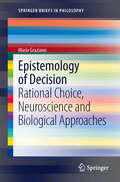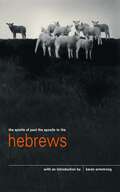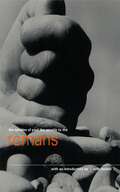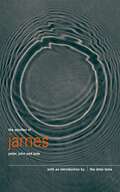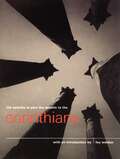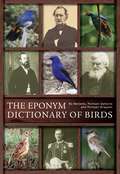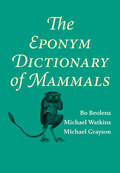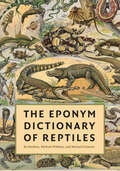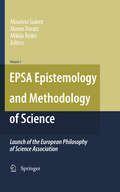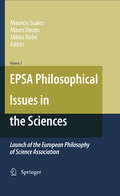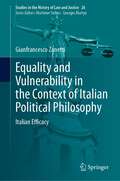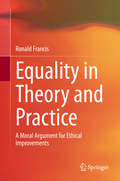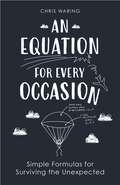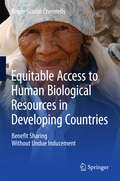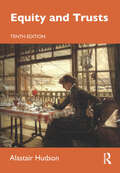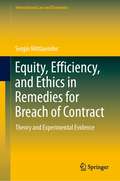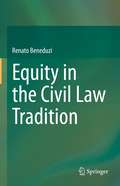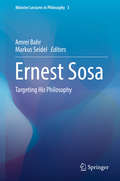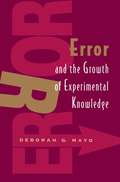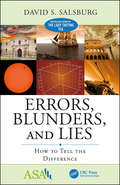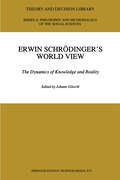- Table View
- List View
Epistemology of Decision: Rational Choice, Neuroscience and Biological Approaches (SpringerBriefs in Philosophy)
by Mario GrazianoThis book carries out an epistemological analysis of the decision, including a critical analysis through the continuous reference to an interdisciplinary approach including a synthesis of philosophical approaches, biology and neuroscience. Besides this it represents the analysis of causality here seen not from the formal point of view, but from the "embodied" point of view.
The Epistle of Paul the Apostle to The Hebrews (The Pocket Canons #21)
by Karen ArmstrongHebrews marks a parting of the ways for Jews and Christians of the first century. It makes a case for the superiority of the new Christian 'faith' over old Hebrew orthodoxy and draws on the Old Testament for precedents for Jesus's ministry and to paint a picture of Jesus.
The Epistle of Paul the Apostle to The Romans (The Pocket Canons #20)
by Ruth RendellPaul was the most influential figure in the early Christian church. In this epistle, written to the founders of the church in Rome, he sets out some of his ideas on the importance of faith in overcoming mankind's innate sinfulness and in obtaining redemption. With an introduction by Ruth Rendell
The Epistles of James, Peter, John and Jude (The Pocket Canons #22)
by Dalai LamaAlongside the epistles of Paul in the New Testament are short letters of four unknown early Christian writers, James, Peter, John and Jude. Those of Peter were composed in excellent Greek, James emphasizes the need for good works and Peter berates false prophets. With an introduction by the Dalai Lama.
The Epistles of Paul the Apostle to The Corinthians (The Pocket Canons #11)
by Fay WeldonA figurehead of the early Christian church, Paul sets out some of his thoughts on strife and division, spirituality, the bond of marriage and hopes for his own immortality in this book. With an introduction by Fay Weldon
The Eponym Dictionary of Birds
by Bo Beolens Michael Watkins Michael GraysonBirdwatchers often come across bird names that include a person's name, either in the vernacular (English) name or latinised in the scientific nomenclature. Such names are properly called eponyms, and few people will not have been curious as to who some of these people were (or are).Names such as Darwin, Wallace, Audubon, Gould and (Gilbert) White are well known to most people. Keener birders will have yearned to see Pallas's Warbler, Hume's Owl, Swainson's Thrush, Steller's Eider or Brünnich's Guillemot. But few people today will have even heard of Albertina's Myna, Barraband's Parrot, Guerin's Helmetcrest or Savigny's Eagle Owl. This extraordinary new work lists more than 4,000 eponymous names covering 10,000 genera, species and subspecies of birds. Every taxon with an eponymous vernacular or scientific name (whether in current usage or not) is listed, followed by a concise biography of the person concerned. These entries vary in length from a few lines to several paragraphs, depending on the availability of information or the importance of the individual's legacy. The text is punctuated with intriguing or little-known facts, unearthed in the course of the authors' extensive research.Ornithologists will find this an invaluable reference, especially to sort out birds named after people with identical surnames or in situations where only a person's forenames are used. But all birders will find much of interest in this fascinating dictionary, an ebook to dip into time and time again whenever their curiosity is aroused.
The Eponym Dictionary of Birds
by Bo Beolens Michael Watkins Michael GraysonBirdwatchers often come across bird names that include a person's name, either in the vernacular (English) name or latinised in the scientific nomenclature. Such names are properly called eponyms, and few people will not have been curious as to who some of these people were (or are).Names such as Darwin, Wallace, Audubon, Gould and (Gilbert) White are well known to most people. Keener birders will have yearned to see Pallas's Warbler, Hume's Owl, Swainson's Thrush, Steller's Eider or Brünnich's Guillemot. But few people today will have even heard of Albertina's Myna, Barraband's Parrot, Guerin's Helmetcrest or Savigny's Eagle Owl. This extraordinary new work lists more than 4,000 eponymous names covering 10,000 genera, species and subspecies of birds. Every taxon with an eponymous vernacular or scientific name (whether in current usage or not) is listed, followed by a concise biography of the person concerned. These entries vary in length from a few lines to several paragraphs, depending on the availability of information or the importance of the individual's legacy. The text is punctuated with intriguing or little-known facts, unearthed in the course of the authors' extensive research.Ornithologists will find this an invaluable reference, especially to sort out birds named after people with identical surnames or in situations where only a person's forenames are used. But all birders will find much of interest in this fascinating volume, a book to dip into time and time again whenever their curiosity is aroused.
The Eponym Dictionary of Mammals
by Michael Watkins Bo Beolens Michael GraysonJust who was the Przewalski after whom Przewalski's horse was named? Or Husson, the eponym for the rat Hydromys hussoni? Or the Geoffroy whose name is forever linked to Geoffroy's cat? This unique reference provides a brief look at the real lives behind the scientific and vernacular mammal names one encounters in field guides, textbooks, journal articles, and other scholarly works.Arranged to mirror standard dictionaries, the more than 1,300 entries included here explain the origins of over 2,000 mammal species names. Each bio-sketch lists the scientific and common-language names of all species named after the person, outlines the individual's major contributions to mammalogy and other branches of zoology, and includes brief information about his or her mammalian namesake's distribution. The two appendixes list scientific and common names for ease of reference, and, where appropriate, individual entries include mammals commonly—but mistakenly—believed to be named after people.The Eponym Dictionary of Mammals is a highly readable and informative guide to the people whose names are immortalized in mammal nomenclature.
The Eponym Dictionary of Reptiles
by Bo Beolens Michael Watkins Michael GraysonWho was Richard Kemp, after whom the Kemp’s ridley sea turtle is named? Is Wake’s Gecko named after Berkeley’s Marvalee Wake? Or perhaps her husband, David? Why do so many snakes and lizards have Werner in their name? This reference book answers these and thousands of other questions about the origins of the vernacular and scientific names of reptiles across the globe.From Agkistrodon piscivorus conanti, the Florida cottonmouth subspecies named for Roger Conant, to Xantusia, the night lizard genera namesake of John Xantus, this dictionary covers everyone after whom an extant or recently extinct reptile has been named. The entries include a brief bio-sketch, a list of the reptiles that bear the individual’s name, the names of reptiles erroneously thought to be associated with the person, and a summary of major—and sometimes obscure or even incidental—contributions made by the person to herpetology and zoology. An introductory chapter explains how to use the book and describes the process of naming taxa. Easy to use and filled with addictive—and highly useful—information about the people whose names will be carried into the future on the backs of the world’s reptiles, The Eponym Dictionary of Reptiles is a handy and fun book for professional and amateur herpetologists alike.
The Eponym Dictionary of Reptiles
by Michael Watkins Bo Beolens Michael GraysonWho was Richard Kemp, after whom the Kemp’s ridley sea turtle is named? Is Wake’s Gecko named after Berkeley’s Marvalee Wake? Or perhaps her husband, David? Why do so many snakes and lizards have Werner in their name? This reference book answers these and thousands of other questions about the origins of the vernacular and scientific names of reptiles across the globe.From Agkistrodon piscivorus conanti, the Florida cottonmouth subspecies named for Roger Conant, to Xantusia, the night lizard genera namesake of John Xantus, this dictionary covers everyone after whom an extant or recently extinct reptile has been named. The entries include a brief bio-sketch, a list of the reptiles that bear the individual’s name, the names of reptiles erroneously thought to be associated with the person, and a summary of major—and sometimes obscure or even incidental—contributions made by the person to herpetology and zoology. An introductory chapter explains how to use the book and describes the process of naming taxa. Easy to use and filled with addictive—and highly useful—information about the people whose names will be carried into the future on the backs of the world’s reptiles, The Eponym Dictionary of Reptiles is a handy and fun book for professional and amateur herpetologists alike.
EPSA Epistemology and Methodology of Science: Launch of the European Philosophy of Science Association
by Mauricio Suárez Miklós Rédei Mauro DoratoThese two volumes containa selection of the papers delivered at the rst conference of the European Philosophy of Science Association (EPSA) which took place in Madrid,at Complutense University,from 14 to 17 November 2007.
EPSA Philosophical Issues in the Sciences: Launch of the European Philosophy of Science Association
by Mauricio Suárez Mauro Dorato Miklós RédeiThis volume collects papers presented at the Founding Conference of the European Philosophy of Science Association meeting, held November 2007. It provides an excellent overview of the state of the art in philosophy of science in different European countries.
Equality and Vulnerability in the Context of Italian Political Philosophy: Italian Efficacy (Studies in the History of Law and Justice #26)
by Gianfrancesco ZanettiOne of the main goals of this book is to determine if, in the works of some of the key authors in the history of Italian political philosophy, a notion of “efficacy” can be found. In legal philosophy, “efficacy” is the capacity a norm has to effectively influence citizens’ behavior. The “principle of efficacy” is that according to which an order or rule exists as such when it is followed effectively in practice. Here by “efficacy” I mean the idea that normative phenomena are self-justifying, without reference to extrinsic systems of value (such as “natural law”). The examinations of several texts undertaken here constitute reflections on this theme, without any claim to systematicity. They have been grouped together, roughly in historical order, by their common respect for the contexts within which they reason and reach decisions, which lends them a characteristic flavor of harsh realism that at times relies on a minimalist use of traditional normative categories.The second theme that emerges through the respective chapters (each of which constitutes the text for a lesson in a course for Ph.D. students) is that of the relationship between “equality” and “vulnerability.” Here the idea is to elaborate a concept of “vulnerability” that is not underpinned by what we in Italy call an “anthropology,” that is, a fixed notion of human nature. Instead this concept should be comprehensible and graspable solely on the basis of the recognition of decisions and actions that are merely “efficacious,” that function “for what they are, and what they do.” This recognition doesn’t even need to be explicitly articulated by these authors with any specific, deliberately conscious awareness.The goal is not to identify a precise tradition of thought, one which elaborates a given line of reflection, but rather to highlight certain “themes” that emerge in the texts examined, even as the authors write with and for their own specific, contingent set of motives, which differ from time to time and place to place. These authors include some who are widely known, such as Dante, Machiavelli, and Beccaria. At times they are figures who typify certain key historical episodes, such as the Risorgimento (Giuseppe Mazzini) or Fascism (Cesare Lombroso and Santi Romano), while others reflect certain aspects of a contemporary debate (Pasolini and the “Braibanti affair”).The book is based on lectures given for a 2021 Ph.D. Course at the University of California, Berkeley’s Department of Italian Studies.
Equality in Theory and Practice: A Moral Argument for Ethical Improvements
by Ronald FrancisThis book is an account of the concept of equality from the perspective of both theory and practice, and presents methods of quantifying values. It considers both arguments and evidence, and tackles equality in its different forms, including economic equality, education, equality before the law, equality of opportunity, and gender equality. The book shows that inequality is a profoundly moral question, noting that there are good practical reasons for its adoption. It presents a consideration of classical theories from Aristotle to Hume, as well as contemporary approaches such as those offered by Rawls, Haidt, Temkin, and Parfit. It also contemplates issues such as the naturalistic fallacy, and considers what is different about the Goleman view of moral sensitivity and the ethical personality. The array of evidence includes the impact of climate and various plants such as sugar and cotton on the slave trade, the concept of Gaia, Darwinism, sex inequality, personality, culture, psychological issues, and the quantification of ethics. The book concludes with some practical suggestions for improving equality. It aims to raise awareness of the ways in which equality can be understood, and achieved. It will be relevant to students and scholars in philosophy, human rights, and law.
An Equation for Every Occasion: Simple Formulas for Surviving the Unexpected
by Chris WaringWhether you paid much attention to the mathematics you were taught at school or not, the inescapable truth is that one day, an equation could just save your life.The real world is full of equations and a lot of our everyday decisions are calculated – we just don’t always realize it. And that’s ok – you unthinkingly use differentiation when you’re crossing the road between traffic and you will pretty much always make it to the other side safely. But what if you were plummeting to your death in a plane with no engine and you needed to know what size parachute to make from your cabinmate’s sari in order to jump and survive? Or you were in charge of pinpointing the origins of an important message from outer space? These entirely plausible real-life situations clearly require a little more thought. From how to work out the best guard configuration to protect a world-famous painting in the Louvre to saving the planet from total blackout during an energy crisis, Chris Waring demonstrates the mind-bending and humanity-saving beauty of equations.
Equitable Access to Human Biological Resources in Developing Countries: Benefit Sharing Without Undue Inducement
by Roger Scarlin ChennellsThe main question explored by the book is: How can cross-border access to human genetic resources, such as blood or DNA samples, be governed in such a way as to achieve equity for vulnerable populations in developing countries? The book situates the field of genomic and genetic research within global health and research frameworks, describing the concerns that have been raised about the potential unfairness in exchanges during recent decades. Access to and sharing in the benefits of human biological resources are aspects not regulated by any international legal framework such as the Convention on Biological Diversity, which applies only to the exchange of plants, animals and microorganisms, as well as to associated traditional knowledge. Examples of genetic research perceived as exploitative are provided in order to illustrate the legal vacuum concerning the global governance of human genetic resources. The main conclusions drawn from the legal and ethical analysis are:• Benefit sharing is crucial in order to avoid the exploitation of developing countries in human genetic research.• With functioning research ethics committees, undue inducement is less of a concern in genetic research than in other areas of medical research (e.g. clinical trials).• Concerns remain over research involving indigenous populations; accordingly, recommendations are provided. In drawing these conclusions, the book addresses in detail a highly pressing topic in global bioethics and international law. In this regard, it combines bioethical arguments with jurisprudence, in particular with reference to the law of equity and the legal concepts of duress (coercion), unconscionable dealing, and undue inducement.
Equity and Trusts
by Alastair HudsonAlastair Hudson’s Equity and Trusts is an ideal textbook for undergraduate courses on the law of trusts and equitable remedies. It provides a clear, current and comprehensive account of the subject. The author’s enthusiasm and expertise shine through, helping to bring to life an area of the law which students often fi nd challenging. The tenth edition of Equity and Trusts remains the most comprehensive and up-to-date coverage of the law of Equity and Trusts, while still a lively and thoughtful account of the issues raised by it. This book has been cited as being authoritative in the courts of numerous countries. The tenth edition is supported by the author’s website at www.alastairhudson.com with brand new resources including: • short podcasts discussing and clarifying key topics from within the book, which cover an entire course; • complete lecture recordings made specifi cally to accompany this book; • video documentaries bringing to life selected key topics; • a host of other online materials and study guides new for 2021.
Equity and Trusts
by Alastair HudsonAlastair Hudson’s Equity and Trusts is an ideal textbook for undergraduate courses on the law of trusts and equitable remedies. It provides a clear, current and comprehensive account of the subject. The author’s enthusiasm and expertise shine through, helping to bring to life an area of the law which students often fi nd challenging. The tenth edition of Equity and Trusts remains the most comprehensive and up-to-date coverage of the law of Equity and Trusts, while still a lively and thoughtful account of the issues raised by it. This book has been cited as being authoritative in the courts of numerous countries. The tenth edition is supported by the author’s website at www.alastairhudson.com with brand new resources including: • short podcasts discussing and clarifying key topics from within the book, which cover an entire course; • complete lecture recordings made specifi cally to accompany this book; • video documentaries bringing to life selected key topics; • a host of other online materials and study guides new for 2021.
Equity, Efficiency, and Ethics in Remedies for Breach of Contract: Theory and Experimental Evidence (International Law and Economics)
by Sergio MittlaenderThis book analyzes the conflict that emerges between parties after a breach of contract and how different legal remedies can best reduce conflict. Causes for conflict include equity, efficiency, and ethical reasons that parties might consider and use to blame the other or to justify breach. In the end, if not resolved through apologies or renegotiation, conflict leads to aggrievement and behavioral reactions in form of retaliation by the victim against the promisor in breach. The book provides empirical evidence from laboratory experiments for how individuals react to perceived wrongful acts such as breach of contract and for the function of legal remedies to reduce retaliation by disappointed promisees in providing them compensation. It reveals how the inequality in the outcome, and not the inefficiency of breach of contract, causes aggrievement and retaliation by victims. The book concludes with a comparative law and economic analysis of remedies for breach of contract adopted in different leading jurisdictions, with important normative implications for the American insistence on expectation damages, the French expansion of specific performance with "astreinte", the German junction of specific performance, expectation damages, and disgorgement damages, and the British timid acceptance of partial disgorgement damages.The book will appeal to scholars, researchers, and students of economics and law, interested in a better understanding of remedies for breach of contract.
Equity in the Civil Law Tradition
by Renato BeneduziThis is a book on “equity in the civil law tradition” from the double perspective of legal history and comparative law. It is intended not only for civil lawyers who want to better understand the role and history of equity in their own legal tradition, but also – and perhaps more saliently – for common lawyers who are curious about why the history of equity has unfolded so differently on the continent of Europe and in Latin America. The author begins with the investigation of the philosophical foundations of the Western notion of equity in the teachings of Plato and Aristotle and of how their ideas affected the works of the great Attic orators (chapter 2). He then addresses the way in which Roman law turned this notion into a legal concept of considerable practical importance (chapter 3) and how it survived the fall of Rome and was later elaborated in the Middle Ages by civilists and canonists (chapter 4). Subsequently, the author analyses how the notion of equity was dealt with in the Modern Era by legal humanists, Protestant and Catholic theologians, scholars of the usus modernus pandectarum and of Roman-Dutch law, and then by legal rationalism and the philosophers of the Enlightenment (chapter 5). He then deals with the history of equity on the continent since the fragmentation of the ius commune and the codifications of the nineteenth century and with its reception in Latin America (chapter 6). Finally, the author offers some closing remarks on the fundamental equivocalness (or relativity, as some scholars put it) of the notion of equity in the civil law tradition today (conclusion).
Ernest Sosa: Targeting His Philosophy (Münster Lectures in Philosophy #3)
by Amrei Bahr Markus SeidelThis volume provides the reader with exclusive insights into Ernest Sosa’s latest ideas as well as main aspects of his philosophical work of the last 50 years. Ernest Sosa, one of the most distinguished contemporary philosophers, is best known for his ground-breaking work in epistemology, and has also contributed greatly to metaphysics, metaphilosophy and philosophy of language.This book, resulting from the 18th Münster Lectures in Philosophy, includes an original article by Sosa on his most recent work in epistemology, and seven critical papers that target a wide range of topics from Sosa’s oeuvre, as well as Sosa’s responses. As regards his epistemology, the issues discussed include his solution of the sceptical problem in his most recent work and the question of how to integrate a sensible account of testimony to Sosa’s virtue epistemology. The selected topics from his other fields of inquiry include his view on empirical challenges to human rationality, his defense of the scientific status of philosophy, his concept of causality as considered against the background of the current debate, his suggestion of a middle-way between existential relativism and absolutism and his externalistic internalism in the philosophy of mind and language.
Error and the Growth of Experimental Knowledge (Science and Its Conceptual Foundations series)
by Deborah G. MayoWe may learn from our mistakes, but Deborah Mayo argues that, where experimental knowledge is concerned, we haven't begun to learn enough. Error and the Growth of Experimental Knowledge launches a vigorous critique of the subjective Bayesian view of statistical inference, and proposes Mayo's own error-statistical approach as a more robust framework for the epistemology of experiment. Mayo genuinely addresses the needs of researchers who work with statistical analysis, and simultaneously engages the basic philosophical problems of objectivity and rationality. Mayo has long argued for an account of learning from error that goes far beyond detecting logical inconsistencies. In this book, she presents her complete program for how we learn about the world by being "shrewd inquisitors of error, white gloves off." Her tough, practical approach will be important to philosophers, historians, and sociologists of science, and will be welcomed by researchers in the physical, biological, and social sciences whose work depends upon statistical analysis.
Errors, Blunders, and Lies: How to Tell the Difference (ASA-CRC Series on Statistical Reasoning in Science and Society)
by David S. SalsburgWe live in a world that is not quite "right." The central tenet of statistical inquiry is that Observation = Truth + Error because even the most careful of scientific investigations have always been bedeviled by uncertainty. Our attempts to measure things are plagued with small errors. Our attempts to understand our world are blocked by blunders. And, unfortunately, in some cases, people have been known to lie. In this long-awaited follow-up to his well-regarded bestseller, The Lady Tasting Tea, David Salsburg opens a door to the amazing widespread use of statistical methods by looking at historical examples of errors, blunders and lies from areas as diverse as archeology, law, economics, medicine, psychology, sociology, Biblical studies, history, and war-time espionage. In doing so, he shows how, upon closer statistical investigation, errors and blunders often lead to useful information. And how statistical methods have been used to uncover falsified data. Beginning with Edmund Halley’s examination of the Transit of Venus and ending with a discussion of how many tanks Rommel had during the Second World War, the author invites the reader to come along on this easily accessible and fascinating journey of how to identify the nature of errors, minimize the effects of blunders, and figure out who the liars are.
Errors, Blunders, and Lies: How to Tell the Difference (ASA-CRC Series on Statistical Reasoning in Science and Society)
by David S. SalsburgWe live in a world that is not quite "right." The central tenet of statistical inquiry is that Observation = Truth + Error because even the most careful of scientific investigations have always been bedeviled by uncertainty. Our attempts to measure things are plagued with small errors. Our attempts to understand our world are blocked by blunders. And, unfortunately, in some cases, people have been known to lie. In this long-awaited follow-up to his well-regarded bestseller, The Lady Tasting Tea, David Salsburg opens a door to the amazing widespread use of statistical methods by looking at historical examples of errors, blunders and lies from areas as diverse as archeology, law, economics, medicine, psychology, sociology, Biblical studies, history, and war-time espionage. In doing so, he shows how, upon closer statistical investigation, errors and blunders often lead to useful information. And how statistical methods have been used to uncover falsified data. Beginning with Edmund Halley’s examination of the Transit of Venus and ending with a discussion of how many tanks Rommel had during the Second World War, the author invites the reader to come along on this easily accessible and fascinating journey of how to identify the nature of errors, minimize the effects of blunders, and figure out who the liars are.
Erwin Schrödinger’s World View: The Dynamics of Knowledge and Reality (Theory and Decision Library A: #16)
by Johann GötschlErwin Schrödinger is one of the greatest figures of theoretical physics, but there is another side to the man: not only did his work revolutionize physics, it also radiacally changed the foundations of our modern worldview, modern biology, philosophy of science, philosophy of the mind, and epistemology. This book explores the lesser-known aspects of Schrödinger's thought, revealing the physicist as a philosopher and polymath whose highly original ideas anticipated the current merging of the natural and the social sciences and the humanities. Thirteen renowned scientists and philosophers have contributed to the volume. Part I reveals the philosophical importance of Schrödinger's work as a physicist. Part II examines his theory of life and of the self-organization of matter. Part III shows how Schrödinger's ideas have influenced contemporary philosophy of nature and our modern view of the world, drawing a fascinating picture of the ongoing synthesis of nature and culture: one of the most interesting developments of modern thought. The volume also contains the most comprehensive bibliography of Schrödinger's scientific work, making it at the same time a book of acute contemporary relevance and a major work of reference.
